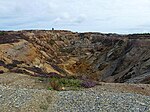St Tyfrydog's Church, Llandyfrydog is a small medieval church, in Llandyfrydog, Anglesey, north Wales. The date of establishment of a church on this site is unknown, but one 19th-century Anglesey historian says that it was about 450. The oldest parts of the present building (such as the nave and the chancel arch) are dated to about 1400, with the chancel dating from the late 15th or early 16th century. It is built from rough, small, squared stones, dressed with limestone. One of the windows on the south side is raised to illuminate the pulpit, a decision that in the eyes of one 19th-century commentator "disfigures the building."According to local tradition, a standing stone about 1 mile (1.6 km) away is the petrified remains of a man who stole a bible from the church and was punished by St Tyfrydog as a result. The Welsh historian Gerald of Wales said that when the Norman lord Hugh of Montgomery was putting down the Welsh revolt led by Gruffudd ap Cynan in 1098, he kept his dogs in the church. The dogs had gone mad by the morning, and Montgomery himself was killed within a week.
The church is still in use for worship, as part of the Church in Wales, as one of four churches in a combined parish. It is a Grade II* listed building, a national designation given to "particularly important buildings of more than special interest", in particular because it is a "good Medieval rural church which retains much of its Medieval fabric". The circular churchyard walls and an 18th-century sundial in the churchyard have also been given listed building status.








